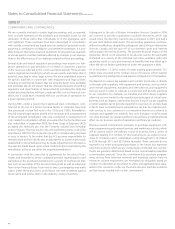Verizon Wireless 2010 Annual Report Download - page 69
Download and view the complete annual report
Please find page 69 of the 2010 Verizon Wireless annual report below. You can navigate through the pages in the report by either clicking on the pages listed below, or by using the keyword search tool below to find specific information within the annual report.
Notes to Consolidated Financial Statements continued
67
NOTE 13
INCOME TAXES
The components of income before provision (benefit) for income taxes
are as follows:
(dollars in millions)
Years Ended December 31, 2010 2009 2008
Domestic $ 11,921 $ 12,625 $ 722
Foreign 763 895 921
Total $ 12,684 $ 13,520 $ 1,643
The components of the provision (benefit) for income taxes are as follows:
(dollars in millions)
Years Ended December 31, 2010 2009 2008
Current
Federal $ (705) $ (611) $ 365
Foreign (19) 73 240
State and Local (42) 364 544
Total (766) (174) 1,149
Deferred
Federal 2,945 1,616 (2,411)
Foreign (24) (35) (91)
State and Local 316 518 (960)
Total 3,237 2,099 (3,462)
Investment tax credits (4) (6) (6)
Total income tax provision (benefit) $ 2,467 $ 1,919 $ (2,319)
The following table shows the principal reasons for the difference
between the effective income tax rate and the statutory federal income
tax rate:
Years Ended December 31, 2010 2009 2008
Statutory federal income tax rate 35.0 % 35.0 % 35.0 %
State and local income tax rate,
net of federal tax benefits 1.4 1.5 (16.5)
Distributions from foreign investments – – (4.3)
Medicare Part D subsidy charge 6.9 – –
Equity in earnings from
unconsolidated businesses (1.6) (1.6) (14.0)
Noncontrolling interest (19.5) (16.0) (119.4)
Other, net (2.8) (4.7) (22.0)
Effective income tax rate 19.4 % 14.2 % (141.2)%
The effective income tax rate in 2010 increased to 19.4% from 14.2% in
2009. The increase was primarily driven by a one-time, non-cash income
tax charge of $1.0 billion. The one-time non-cash income tax charge was
a result of the enactment of the Patient Protection and Affordable Care
Act and the Health Care and Education Reconciliation Act of 2010, both
of which became law in March 2010 (collectively the Health Care Act).
Under the Health Care Act, beginning in 2013, Verizon and other com-
panies that receive a subsidy under Medicare Part D to provide retiree
prescription drug coverage will no longer receive a federal income tax
deduction for the expenses incurred in connection with providing the
subsidized coverage to the extent of the subsidy received. Because future
anticipated retiree prescription drug plan liabilities and related subsi-
dies were already reflected in Verizon’s financial statements, this change
required Verizon to reduce the value of the related tax benefits recog-
nized in its financial statements in the period during which the Health
Care Act was enacted. The increase was partially offset by higher earnings
attributable to the noncontrolling interest.
During 2008, we recorded a pension and postretirement benefit plan
remeasurement loss rendering the 2008 effective tax rate not mean-
ingful. Excluding the tax impact of this actuarial loss in 2008, the effective
income tax rate decreased in 2009 primarily driven by higher earnings
attributable to the noncontrolling interest. Included within the (4.7)%
‘Other net’ above is the impact of lower federal taxes, net of higher state
taxes attributable to prior year adjustments to tax balances that were not
material to the overall effective income tax rate.
Excluding the tax impact of the actuarial loss in 2008, the state and local
income tax rate decreased due to tax benefits recognized after statutes
of limitations in multiple jurisdictions lapsed and the impact of earnings
attributable to the noncontrolling interest.
























